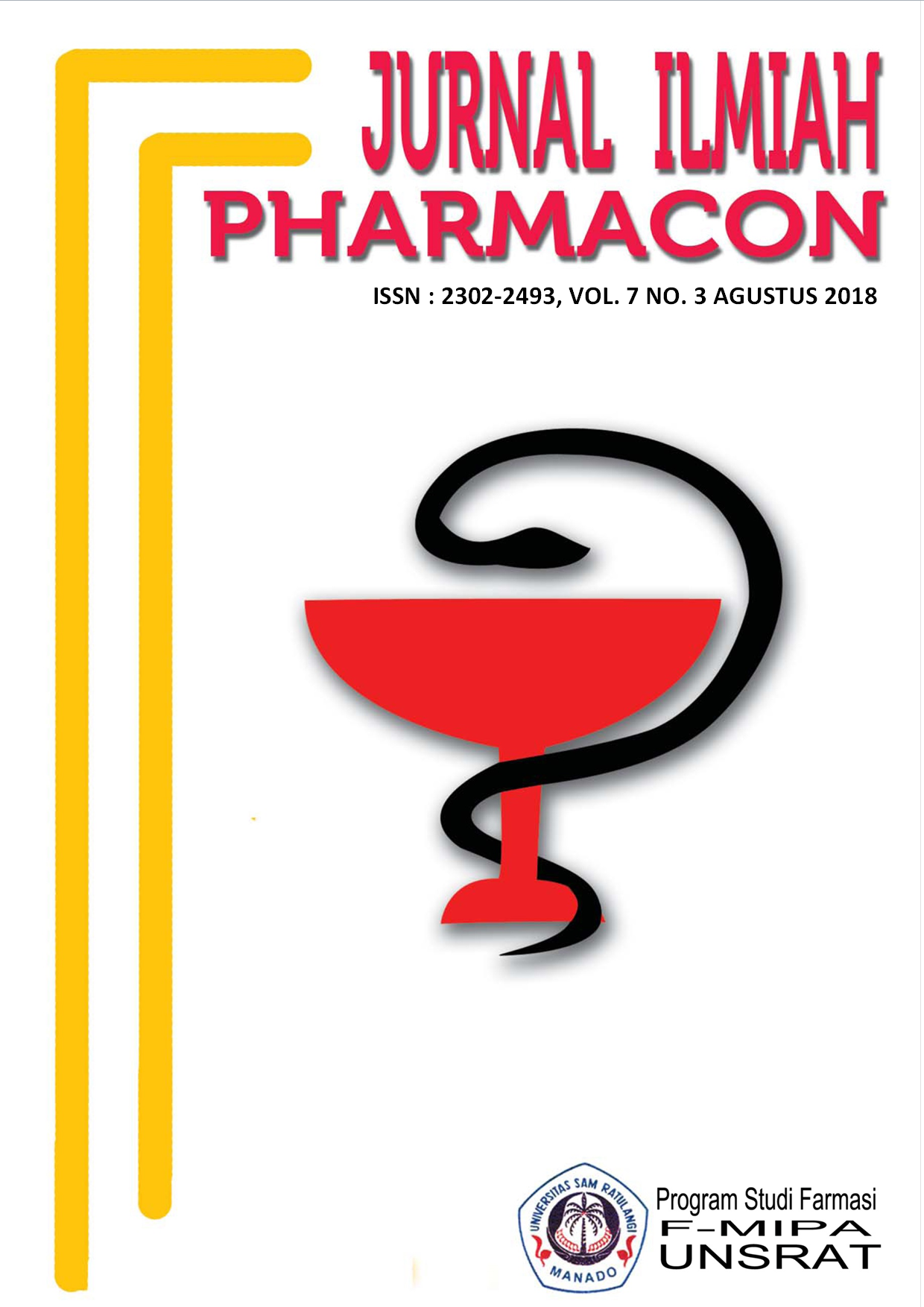ISOLASI DAN IDENTIFIKASI BIOMOLEKULER BAKTERI PENYEBAB PNEUMONIA YANG RESISTEN SEFTRIAKSON DI RSUP PROF. DR. R. D. KANDOU MANADO
DOI:
https://doi.org/10.35799/pha.7.2018.20240Abstract
ISOLASI DAN IDENTIFIKASI BIOMOLEKULER BAKTERI
PENYEBAB PNEUMONIA YANG RESISTEN SEFTRIAKSON
DI RSUP PROF. DR. R. D. KANDOU MANADO
Harum Maranatha Latuharhary1), Fatimawali1), Beivy J. Kolondam2)
1)Program Studi Farmasi FMIPA UNSRAT Manado, 95115
2)Program Studi Biologi FMIPA UNSRAT Manado, 95115
ABSTRACT
Bacteria are microorganisms that can cause disease and one example is pneumonia. The occurrence of pneumonia is caused by the entry of bacteria to the peripheral passage of the lungs through the respiratory channel resulting in inflammation. The choice of ceftriaxone as antibiotic is associated with its use in the treatment of pneumonia. This study aims to identify ceftriaxone-resistant bacteria isolated from pneumonia patient’s sputum based on 16S rRNA gene sequence. Sputum samples were taken from two participants of pneumonia patients and then tested the resistance of bacteria to ceftriaxone. The result showed three resistant isolates (50%), two intermediates isolates (33%), and one sensitive isolates (17%). The bacteria isolates were then identified using 16S rRNA gene sequence. Based on the small diameter of the inhibition zone formed, one isolate was selected with the highest resistance to be identified. BLAST (Basic Local Alignment Search Tool) result was accessed online (https://blast.ncbi.nlm.nih.gov) that shows the closest similarity the nucleotide sequence of the bacterial 16S rRNA gene in the GenBank. The isolate is identical (100% similar) with Klebsiella pneumonia in the GenBank.
Keywords: Pneumonia, sputum, antibiotic resistant bacteria, Ceftriaxone, 16S rRNA Gene.
ABSTRAK
Bakteri merupakan mikroorganisme yang dapat menyebabkan penyakit dan salah satu penyakit yang disebabkan oleh bakteri adalah pneumonia. Terjadinya penyakit pneumonia diakibatkan oleh masuknya bakteri ke paru bagian perifer melalui saluran respiratori sehingga terjadi peradangan. Pemilihan seftriakson berkaitan dengan penggunaannya dalam pengobatan pneumonia. Penelitian ini bertujuan untuk mengidentifikasi bakteri resisten seftriakson yang diisolasi dari sputum penderita pneumonia berdasarkan sekuens gen 16S rRNA. Sampel sputum berasal dari 2 partisipan penderita pneumonia kemudian dilakukan uji resistensi terhadap seftriakson. Hasil uji menunjukkan 3 isolat resisten (50%), 2 intermediet (33%), dan 1 sensitif (17%). Isolat bakteri tersebut kemudian diidentifikasi berdasarkan gen 16S rRNA. Berdasarkan kecilnya diameter zona hambat yang dibentuk maka dipilih satu isolat dengan resistensi paling tinggi untuk diidentifikasi. Hasil BLAST (Basic Local Alignment Search Tool) yang diakses secara online (https://blast.ncbi.nlm.nih.gov) menunjukkan kemiripan urutan nukleotida gen 16S rRNA isolat dengan urutan nukleotida gen 16S rRNA bakteri yang ada di GenBank yaitu 100% kemiripan dengan bakteri Klebsiella pneumoniae.
Kata Kunci: Pneumonia, sputum, bakteri resisten antibiotik, Seftriakson, Gen 16S rRNA.
Downloads
Published
How to Cite
Issue
Section
License
Authors who publish with this journal agree to the following terms:
- Authors retain copyright and grant the journal right of first publication with the work simultaneously licensed under a Creative Commons Attribution-NonCommercial 4.0 International License that allows others to share the work with an acknowledgement of the work's authorship and initial publication in this journal.
- Authors are permitted and encouraged to post their work online (e.g., in institutional repositories or on their website) prior to and during the submission process, as it can lead to productive exchanges, as well as earlier and greater citation of published work (See The Effect of Open Access)










